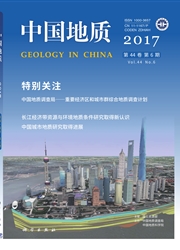

 中文摘要:
中文摘要:
金船塘锡铋矿床是东坡矿田内一以锡铋为主的大型矽卡岩型多金属矿床,迄今为止对其矽卡岩矿物学特征的系统研究较少。本文以金船塘锡铋矿床主要矽卡岩矿物为研究对象,利用电子探针技术对该矿矽卡岩矿物学特征进行了研究。电子探针分析结果表明:金船塘锡铋矿床的矽卡岩中的石榴子石主要为钙铝榴石-钙铁榴石系列,含少量的锰铝榴石,辉石为透辉石-钙铁辉石系列,角闪石主要为铁镁钙闪石,其次为钙镁闪石、阳起石和透闪石,表明该区的矽卡岩为钙质矽卡岩,含少量的锰质矽卡岩。同时,根据矽卡岩矿物学特征的研究,笔者进一步探讨了该矿床锡石的沉淀机制:早期矽卡岩阶段的氧逸度较高,Sn主要以Sn4+的形式替代Fe3+存在于石榴子石中,而在晚期矽卡岩阶段由于氧逸度的降低,Sn主要以Sn2+的形式呈氯的络合物在流体中迁移,由于流体的温度、盐度、pH和氧逸度的变化,Sn2+被氧化成Sn4+,导致锡石沉淀。
 英文摘要:
英文摘要:
The Jinchuantang deposit is a large-size skarn-type tin-bismuth deposit in the Dongpo ore field.Little is known about the mineralogical characteristics of the skarn in the Jinchuantang deposit.Based on microscopic observations and electron microprobe analyses,the authors investigated in detail compositional characteristics of skarn minerals in the Jinchuantang tin-bismuth deposit.The results show that the end member of the garnet is composed mainly of grossularite and andradite,followed by spessartite.The composition of pyroxene is dominated by diopside,with minor hedenbergite.The amphibole comprises mainly ferrotschermakite,followed by tschermakite,actinolite and tremolite.Based on the above data,the authors hold that skarn in the Jinchuantang tin-bismuth deposit is mainly calcareous skarn,with minor manganoan skarn.According to the characteristics of skarn minerals,this paper has further discussed the mechanism of cassiterite precipitation,and considered that tin probably replaced Fe3+ in the form of Sn4+ in the octahedron of crystal structure of andradite at the early skarn stage due to the relatively high oxygen fugacity.At the late skarn stage,however,tin dominantly existent as Sn(II) chloro-complex species was transported in fluid with the decrease of the oxygen fugacity.In the process of fluid evolution,the changes of the temperature,salinity,pH and oxygen fugacity were responsible for cassiterite precipitation because the Sn2+ was oxidized to Sn4+.
 同期刊论文项目
同期刊论文项目
 同项目期刊论文
同项目期刊论文
 Zircon U-Pb ages and Hf isotopes of the granitoids in the Huangshaping mining area and their geologi
Zircon U-Pb ages and Hf isotopes of the granitoids in the Huangshaping mining area and their geologi Disproportionation and thermochemical sulfate reduction reactions in S–H2O–CH4 and S–D2O–CH4 systems
Disproportionation and thermochemical sulfate reduction reactions in S–H2O–CH4 and S–D2O–CH4 systems In situ LA-ICP-MS REE analyses of the skarn garnets from the Jinchuantang tin-bismuth deposit in Hun
In situ LA-ICP-MS REE analyses of the skarn garnets from the Jinchuantang tin-bismuth deposit in Hun A Late Cretaceous tin metallogenic event in Nanling W-Sn metallogenic province: Constraints from U-P
A Late Cretaceous tin metallogenic event in Nanling W-Sn metallogenic province: Constraints from U-P Petrogenesis of the Xihuashan granites in southeastern China: Constraints from geochemistry and in-s
Petrogenesis of the Xihuashan granites in southeastern China: Constraints from geochemistry and in-s Ages and geochemistry of Laojunshan granites in southeastern Yunnan, China: implications for W-Sn po
Ages and geochemistry of Laojunshan granites in southeastern Yunnan, China: implications for W-Sn po SHRIMP U-Pb (zircon), Ar-Ar (muscovite) and Re-Os (molybdenite) isotopic dating of the Taoxikeng tun
SHRIMP U-Pb (zircon), Ar-Ar (muscovite) and Re-Os (molybdenite) isotopic dating of the Taoxikeng tun Age and Geochemistry of Granites in Gejiu area, Yunnan province, SW China: Constraints on their petr
Age and Geochemistry of Granites in Gejiu area, Yunnan province, SW China: Constraints on their petr Petrogenesis and geodynamic implications of Gejiu igneous complex in the western Cathaysia block, So
Petrogenesis and geodynamic implications of Gejiu igneous complex in the western Cathaysia block, So Timing of the formation of the Tianhuashan Basin in northern Wuyi as constrained by geochronology of
Timing of the formation of the Tianhuashan Basin in northern Wuyi as constrained by geochronology of Granite, gabbro and mafic microgranular enclaves in the Gejiu area, Yunnan Province, China: a case o
Granite, gabbro and mafic microgranular enclaves in the Gejiu area, Yunnan Province, China: a case o The origin of the world class tin-polymetallic deposits in the Gejiu district, SW China: constraints
The origin of the world class tin-polymetallic deposits in the Gejiu district, SW China: constraints Re-Os dating of molybdenite from the Xintianling giant tungsten-molybdenum deposit in southern Hunan
Re-Os dating of molybdenite from the Xintianling giant tungsten-molybdenum deposit in southern Hunan 期刊信息
期刊信息
